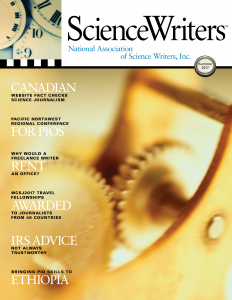By Emily Caldwell
In January, an invitation to speak at a public-health workshop in Ethiopia arrived in my email inbox. The presentation topic was vaguely described as "health communication." I later learned that two colleagues from Ohio State University with ties to the university's public health partnerships in Ethiopia had been the workshop organizers' first and second choice, but were unable to make the trip. Even as a third-string player, I was thrilled to accept.
In short order, I learned that health communication, in this case, meant a discussion about communicating to media and the public the value of scientific research conducted at the Ethiopian Public Health Institute (EPHI) — the East Africa nation's Centers for Disease Control and Prevention equivalent. Given that I am a longtime PIO at Ohio State, including eight years as a science writer covering a health-sciences beat, as it turns out, I was a good fit for this presentation.The university's connection to Ethiopia was no mystery to me. In 2013, I wrote the first news release about Ohio State's work with Ethiopian government agencies, academic institutions, and service organizations to increase the number of professionals trained to deliver all types of health care through an ongoing program now known as the Global One Health initiative (GOHi).
Ohio State and the CDC (a GOHi partner) organized the February 2017 leadership and management workshop to provide applied education and training for 22 EPHI division leaders and a newly appointed director general to support their reexaminiation of the agency's structure, operations, grant-writing practices, and communication strategies.
The intensive two-and-a-half-day workshop was held at EPHI's shiny new National Public Health Training Center, a month before the building was officially opened for use. (The facility was built by the CDC with U.S. AIDS relief funding.) I was an outlier among the instructors: a small group of physicians and public health specialists from Ohio State and the CDC, who are partners in a multiyear global health security cooperative agreement.
Over the course of two days, I covered the basics of Ohio State's approach to research communication:
- Summarize primary finding(s) — avoid technical terms
- Focus on why the research is important/if applicable, how it will improve lives
- Describe the research question
- Explain how you arrived at your answer
This being a workshop, I hoped that discussing examples of the typical science translation process — journal article to press release to media coverage — would be beneficial to the audience, which included EPHI scientists, administrative directors, and public relations staff. I picked topics that could be useful to the scientists, whose concerns range from malnutrition to widespread rabies.
One example featured was the case of a veterinary medicine study finding that pigs raised without antibiotics were more likely to carry food-borne pathogens than conventionally raised swine.
- Journal article title: "Seroprevalence of Trichinella, Toxoplasma, and Salmonella in Antimicrobial-Free and Conventional Swine Production Systems"
- News release headline: "Pigs Raised Without Antibiotics More Likely to Carry Bacteria, Parasites"
- New York Times op-ed headline: "Free-Range Trichinosis"
Just noting the vastly different language used in the various headlines clearly demonstrated the need for translation.
Other story topics discussed in this manner included development of cheap home-based malaria testing and ibuprofen's benefits to aging lungs in the context of reducing inflammation associated with tuberculosis.
I also ran the group through an exercise, starting with a journal abstract about a study suggesting that women pregnant with girls have a higher inflammatory response to immune challenges than do pregnant women carrying boys. I asked attendees to individually prepare summary points that could function as a guide for an interview with a reporter.
The discussion revealed a stark difference between university-based science communication and the mission of EPHI to improve Ethiopians' health. Why, participants asked, did our summary omit research-based advice to the public?
Only sometimes, I explained, will a researcher carry the implications of a single study that far. And very rarely, I added, do university scientists also make policy in the way that public health agency researchers do.
Based on the EPHI public relations director's workshop presentation about his staff's responsibilities, I can see he faces a classic dilemma when it comes to effectively communicating science: too few people to do too much other work. But I know the research stories are there. I hope someday he'll get a chance to tell them.
Emily Caldwell is media relations manager at Ohio State University.
(NASW members can read the rest of the Summer 2017 ScienceWriters by logging into the members area.) Free sample issue. How to join NASW.


